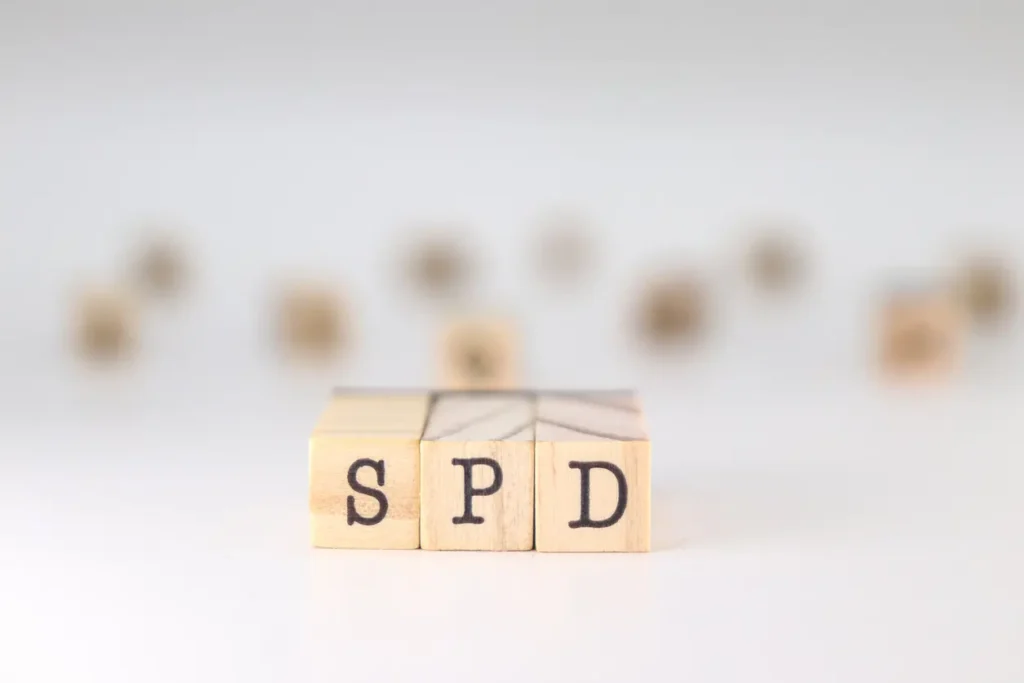
Story at-a-glance
- Sensory Processing Disorder (SPD) affects how the brain receives and responds to sensory information, impacting 5-16% of school-aged children and often underlying academic difficulties that are frequently misdiagnosed as behavioral problems.
- Our sensory systems extend beyond the traditional five senses to include proprioception (body awareness), vestibular sense (balance and movement), and interoception (internal sensations), all crucial for learning and behavior.
- Groundbreaking research using brain imaging has provided biological evidence that SPD is a distinct condition, showing measurable differences in white matter structure in the brains of affected children.
- Sensory processing issues generally fall into three main categories: sensory over-responsivity (hypersensitivity), sensory under-responsivity (hyposensitivity), and sensory seeking, with many children experiencing a combination of these patterns.
- In the classroom, these issues affect reading (difficulty tracking print), writing (handwriting challenges), math (visual-spatial difficulties), and most significantly, attention and behavior—with studies showing 40-60% of children diagnosed with ADHD also have significant sensory processing issues.
- Red flags include behavioral indicators (extreme reactions to sensory input, meltdowns during transitions), academic signs (inconsistent performance, better verbal than written skills), and physical signs (poor coordination, unusual pencil grip).
- Case studies illustrate how children labeled as “behavior problems,” “anxious students,” or “underachievers” often have underlying sensory issues that, when properly addressed, lead to significant improvements in school performance.
- Sensory integration therapy delivered by specialized occupational therapists has shown strong positive effects on goal attainment, motor skills, self-regulation, anxiety reduction, and social participation.
- Parents can support sensory development at home through activities targeting proprioception (heavy work, climbing), vestibular processing (swinging, balancing), tactile sensitivity (varied textures), and visual/auditory processing.
- This understanding represents a fundamental shift from asking “What’s wrong with this child?” to “What is this child experiencing, and how can we support their unique sensory needs?
In today’s classrooms, many children struggle not because they lack intelligence or motivation, but because their nervous systems process sensory information differently. These children may have what’s known as Sensory Processing Disorder (SPD), a condition that affects how the brain receives and responds to information through the senses. For parents and educators seeking to understand learning challenges, recognizing sensory processing issues is crucial—they often underlie or exacerbate academic difficulties and are frequently misdiagnosed as behavioral problems.
Understanding Sensory Processing: Beyond the Five Senses
When most people think about senses, they consider the familiar five: sight, sound, taste, smell, and touch. However, our sensory systems are much more complex, including three additional crucial senses that significantly impact learning and behavior:
- Proprioception (body awareness): The sense that tells you where your body parts are in space without looking at them
- Vestibular sense (balance and movement): The system that processes information about movement, gravity, and balance through the inner ear
- Interoception (internal sensations): Awareness of internal bodily states such as hunger, thirst, need for the bathroom, and emotions
Dr. A. Jean Ayres, the occupational therapist who pioneered sensory integration theory, described sensory processing as “the neurological process that organizes sensation from one’s own body and the environment and makes it possible to use the body effectively within the environment.”
In children with typical sensory processing, these systems work together seamlessly, allowing them to filter out unimportant sensory input while focusing on what’s relevant. For children with sensory processing disorders, however, the brain struggles to organize and respond to sensory information appropriately.
Prevalence and Recognition of Sensory Processing Issues
Research from the STAR Institute for Sensory Processing Disorder suggests that sensory processing issues affect 5-16% of school-aged children. Despite this prevalence, SPD is not yet recognized as a standalone diagnosis in the Diagnostic and Statistical Manual of Mental Disorders (DSM-5), though sensory issues are acknowledged as a common feature of autism spectrum disorder, ADHD, and other developmental conditions.
A groundbreaking study published in 2013 by researchers at the University of California, San Francisco, provided the first biological evidence of SPD as a distinct condition. Using advanced brain imaging techniques (DTI—Diffusion Tensor Imaging), they found measurable differences in white matter brain structure in children with SPD compared to typically developing peers, particularly in areas connecting sensory regions of the brain.
Dr. Lucy Jane Miller, founder of the STAR Institute, notes: “These children are not just being difficult or seeking attention. Their brains are wired differently, affecting how they experience and respond to the world around them.”
Types of Sensory Processing Challenges
Sensory processing issues generally fall into three main categories, though many children experience a combination of these:
1. Sensory Over-Responsivity (Hypersensitivity)
Children who are over-responsive to sensory input experience sensations more intensely than their peers. Common signs include:
- Covering ears when hearing ordinary sounds like announcements over the PA system
- Extreme distress over clothing tags, seams, or certain fabric textures
- Strong negative reactions to ordinary smells like perfumes or cafeteria food
- Avoidance of touch or unexpected physical contact
- Distress in busy, noisy environments like cafeterias or assemblies
- Excessive fear of movement activities or heights
Classroom Impact: These children often appear anxious, withdrawn, or prone to meltdowns in stimulating environments. They may struggle to concentrate because sensory input that others barely notice feels overwhelming and distracting to them.
2. Sensory Under-Responsivity (Hyposensitivity)
Children who are under-responsive to sensory input register sensations less intensely than their peers. Common signs include:
- Seeming oblivious when their name is called
- High pain tolerance, sometimes not noticing injuries
- Craving intense flavors, sounds, or visual stimulation
- Not recognizing when they need to use the bathroom
- Difficulty understanding personal space
- Applying excessive pressure when writing or handling objects
Classroom Impact: These children may appear inattentive, lethargic, or unmotivated. They often need more intense sensory input to maintain an alert state for learning, which can lead to fidgeting, touching everything, or making noise to self-stimulate.
3. Sensory Seeking
Sensory seekers actively pursue sensory experiences to satisfy an intense craving for sensory input. Common signs include:
- Constant movement, jumping, spinning, or crashing
- Touching everything and everyone
- Chewing on pencils, clothing, or other objects
- Making repetitive noises or humming
- Seeking strong tastes or smells
- Enjoying roughhousing or crash play
Classroom Impact: These children are often labeled as “behavior problems” due to their apparent inability to sit still, keep their hands to themselves, or work quietly. Their sensory seeking is frequently misinterpreted as deliberate disruption rather than a neurological need.
4. Sensory Discrimination Issues
Some children struggle to interpret the specific qualities of sensory input, even when their detection of sensations is normal. Signs include:
- Difficulty distinguishing between similar letters or sounds
- Problems with handwriting or copying from the board
- Clumsiness or poor body awareness
- Trouble following multi-step verbal directions
- Difficulty distinguishing relevant sensory information (like the teacher’s voice) from background noise
Classroom Impact: These children often struggle with foundational academic skills like reading, writing, and listening comprehension due to their difficulty processing and organizing sensory information.
The Hidden Impact on Academic Performanc
Sensory processing challenges affect virtually every aspect of classroom functioning:
Reading
For children with visual processing difficulties, tracking print across a page can be exhausting. They may lose their place frequently or struggle to filter out visual distractions on busy worksheet pages. Children with auditory processing issues often struggle with phonics, as they may have difficulty distinguishing between similar sounds.
Writing
Handwriting is one of the most sensory-intensive activities in school, involving fine motor control, proprioception, visual-motor integration, and tactile feedback. Children with sensory issues may press too hard or too lightly, struggle with letter formation, or find the physical act of writing so taxing that they have little cognitive energy left for content.
Research by Drs. Winnie Dunn and Lauren Little found that 85% of children with documented handwriting problems had underlying sensory processing issues.
Math
Visual-spatial difficulties can impact number alignment, geometry, and pattern recognition. Many mathematical concepts rely on sequential processing and mental manipulation of information—tasks that can be challenging for children with sensory processing differences.
Attention and Behavior
Perhaps most significantly, sensory processing issues profoundly affect a child’s ability to regulate their attention and behavior. A child who appears defiant, inattentive, or disruptive may actually be responding to overwhelming sensory input or seeking necessary sensory regulation.
A study published in the Journal of Abnormal Child Psychology found that 40-60% of children diagnosed with ADHD also had significant sensory processing issues, suggesting that some attention difficulties may be secondary to sensory challenges.
Red Flags: Identifying Sensory Processing Issues in the Classroom
Teachers and parents should be alert to these potential indicators of sensory processing challenges:
Behavioral Red Flags
- Extreme reactions to minor sensory events (like covering ears during normal noise levels)
- Frequent meltdowns at transition times or in stimulating environments
- Unusual body movements like rocking, spinning, or hand-flapping
- Refusing to participate in certain activities without clear reason
- Extreme difficulty with changes in routine
- Difficulty transitioning between activities
- Unusual or limited food preferences
- Strong preference for or aversion to physical contact
Academic Red Flags
- Inconsistent performance (good days and bad days)
- Significantly better verbal skills than written work
- Difficulty following multi-step directions
- Strong preference for certain subjects with avoidance of others
- Good understanding of concepts but poor test performance
- Anxiety around specific classroom activities
- Fatigue after activities that require intense sensory focus
Physical Red Flags
- Poor coordination or balance
- Awkward pencil grip or excessive pressure when writing
- Difficulty with fine motor tasks like buttoning or using scissors
- Bumping into objects or people frequently
- Slouching or unusual postures when sitting
- Difficulty with age-appropriate self-care tasks
- Unusual tolerance or intolerance to pain
The Brain-Based Approach: Sensory Integration Therapy
While classroom accommodations are essential, many children with significant sensory processing disorders also benefit from direct intervention through sensory integration therapy. This specialized form of occupational therapy focuses on helping the brain develop more efficient sensory processing through carefully designed sensory-motor activities.
Dr. Lucy Jane Miller explains: “We’re not just managing symptoms; we’re actually changing the way the brain processes sensory information through neuroplasticity—the brain’s ability to reorganize itself by forming new neural connections.”
A meta-analysis published in the American Journal of Occupational Therapy (2018) examining 17 studies found that sensory integration therapy showed strong positive effects on:
- Individual goal attainment
- Improved motor skills
- Improved self-regulation
- Reduced anxiety
- Enhanced social participation
- Greater independence in daily living skills
Sensory integration therapy is typically provided by occupational therapists with specialized training and involves activities that provide precisely controlled sensory input while challenging adaptive responses. Unlike behavioral approaches that aim to extinguish unwanted behaviors, sensory integration therapy addresses the underlying neurological differences that cause those behaviors.
Supporting Sensory Development at Home
Parents can reinforce sensory processing development through everyday activities:
Proprioceptive Activities (Body Awareness)
- Climbing, hanging, pushing, pulling, and carrying heavy objects
- Pillow “sandwiches” (gentle pressure between pillows)
- Animal walks (bear crawls, crab walks)
- Use of weighted blankets (under professional guidance)
- Resistance activities like play-dough and clay
Vestibular Activities (Movement and Balance)
- Swinging, spinning, rolling, and rocking
- Balance games and obstacle courses
- Trampoline jumping with support
- Dancing to varied rhythms
- Yoga and mindfulness activities adapted for children
Tactile Activities (Touch)
- Sensory bins with varied textures
- Finger painting and tactile crafts
- “Texture walks” identifying different surfaces
- Massage or deep pressure with consent
- Water play with different temperatures and tools
Visual Processing Activities
- Visual search activities (like I Spy)
- Puzzles and pattern matching
- Maze books and visual tracking games
- Activities in different lighting conditions
- Visual memory games
Auditory Processing Activities
- Listening games with eyes closed to identify sounds
- Following rhythmic patterns
- Recording and listening to different voice modulations
- Sound discrimination activities
- Practicing focus during different background noise levels
Conclusion: Changing Perspectives, Changing Lives
Understanding sensory processing challenges represents a fundamental shift in how we view children’s learning and behavior difficulties. Rather than asking “What’s wrong with this child?” we begin to ask “What is this child experiencing, and how can we support their unique sensory needs?”
When we recognize that what looks like inattention, defiance, or poor motivation may actually reflect an overwhelmed or under-stimulated nervous system, we open doors to more effective interventions. By modifying environments, teaching self-regulation strategies, and providing appropriate sensory opportunities, we can help children with sensory processing challenges access their true potential.
In the words of Dr. A. Jean Ayres, “When we can experience the world as a place of sensory delight rather than a threat, then we can fully develop as creative, problem-solving individuals, ready to engage with the world on our own terms.”
For the millions of children with sensory processing differences, this understanding isn’t just academic—it’s transformative. It offers the promise of classrooms where they can learn without exhaustion, playgrounds where they can participate without fear, and a world that accommodates rather than pathologizes their neurological differences.
References
- Ayres, A. J. (2005). Sensory Integration and the Child: Understanding Hidden Sensory Challenges. Western Psychological Services.
- Owen, J. P., Marco, E. J., Desai, S., Fourie, E., Harris, J., Hill, S. S., Arnett, A. B., & Mukherjee, P. (2013). Abnormal white matter microstructure in children with sensory processing disorders. NeuroImage: Clinical, 2, 844-853.
- Miller, L. J., Nielsen, D. M., & Schoen, S. A. (2012). Attention deficit hyperactivity disorder and sensory modulation disorder: A comparison of behavior and physiology. Research in Developmental Disabilities, 33(3), 804-818.
- Schoen, S. A., Miller, L. J., Brett-Green, B. A., & Nielsen, D. M. (2009). Physiological and behavioral differences in sensory processing: a comparison of children with Autism Spectrum Disorder and Sensory Processing Disorder. Frontiers in Integrative Neuroscience, 3, 29.
- Dunn, W. (2007). Supporting children to participate successfully in everyday life by using sensory processing knowledge. Infants & Young Children, 20(2), 84-101.
- Parham, L. D., Roley, S. S., May-Benson, T. A., Koomar, J., Brett-Green, B., Burke, J. P., Cohn, E. S., Mailloux, Z., Miller, L. J., & Schaaf, R. C. (2011). Development of a fidelity measure for research on the effectiveness of the Ayres Sensory Integration intervention. American Journal of Occupational Therapy, 65(2), 133-142.
- Schaaf, R. C., Dumont, R. L., Arbesman, M., & May-Benson, T. A. (2018). Efficacy of occupational therapy using Ayres Sensory Integration®: A systematic review. American Journal of Occupational Therapy, 72(1), 7201190010p1-7201190010p10.
- May-Benson, T. A., & Koomar, J. A. (2010). Systematic review of the research evidence examining the effectiveness of interventions using a sensory integrative approach for children. American Journal of Occupational Therapy, 64(3), 403-414.
- Bodison, S. C., & Parham, L. D. (2018). Specific sensory techniques and sensory environmental modifications for children and youth with sensory integration difficulties: A systematic review. American Journal of Occupational Therapy, 72(1), 7201190040p1-7201190040p11.
- Reynolds, S., Lane, S. J., & Gennings, C. (2010). The moderating role of sensory overresponsivity in HPA activity: A pilot study with children diagnosed with ADHD. Journal of Attention Disorders, 13(5), 468-478.
Note: This blog post is intended for educational purposes only. While the information presented is based on scientific research, individual situations vary. Please consult with qualified professionals for proper assessment and individualized recommendations.



